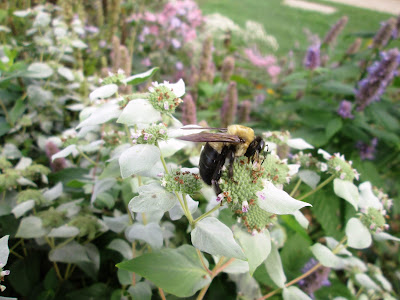The fall color extravaganza of the trees has not quite gotten started here in southern Ohio, but the flower show is continuing, with all the pollinator activity that entails. Goldenrods are the #1 native perennial for lepidoptera, but for some reason, none would cooperate by posing on that particular plant this week, and the goldenrods in the neighborhood have faded in unexpected October heat.
Other plants are soldiering on, including some I did not expect to still see blooming, like the anise hyssop (Agastache foeniculum) that has been a star attraction at the pollinator habitat since at least July.
Its cousin, clustered mountain mint (Pycnanthemum muticum), was in full bloom by mid-July, and at the beginning of the second week of October was still attracting native bees.
The ragged flowers and wandering ways of wingstem (Verbesina alternifolia) are not to everyone's taste--indeed, I have heard these enthusiastic plants referred to as "weeds"--but they are popular with bumblebees and other long-tongued pollinators
and host the caterpillars of the lovely silvery checkerspot. Admittedly, they do produce more seed than is needed in most civilized landscapes, but there is something to be said for any plant that feeds goldfinches, perhaps especially one that manages to camouflage both the gold of the male and the drabber green of the female. For entertainment, I do recommend watching the finches seem to disappear while feeding on this plant.
Hardy ageratum (Conoclinium coelestinum) has also been accused of thuggish tendencies , but it is another star of any native plant garden. Short and bushy enough to hide the naked stems of taller plants, it asks for little and attracts a range of pollinators, including this migrating monarch.
And asters, of course, are essential to any planting of fall flowers. Ohio has at last count thirty-five species of native aster, and except for the ubiquitous New England aster (which really needs a different name, given the size of its range), I confuse many of them. They also attract butterflies,
bees,
and probably every other pollinator except the hummingbird. The exceedingly prolific small-flowered white asters that bloom in shade have been covered with multiple species of wasps and hoverflies this week, though I have managed not to get a photo of any of them. An aster that I love despite its tendency to colonize any available patch of anything that resembles dirt is this blue-flowered beauty, probably the blue wood aster. (I am opting to skip the scientific names of asters as they seem to change frequently, becoming ever-more-difficult to spell or pronounce.) It blooms in nearly any light condition and keeps blooming long after other flowers have given up, literally sometimes into mid-December in sheltered locations.
This specimen was just beginning to bud on October 8.
Late-blooming flowers are essential to migrating monarchs and songbirds, providing nectar, pollen, and seed. Of course, they feed nonmigratory species as well, and their dried stems can provide homes for overwintering insects, particularly solitary bees.
And, usefulness aside, sometimes a person just wants to enjoy color before the landscape turns to brown, grey, and white.















